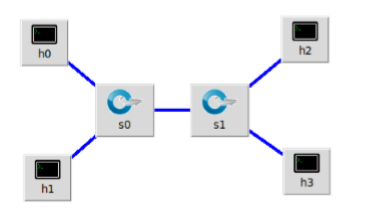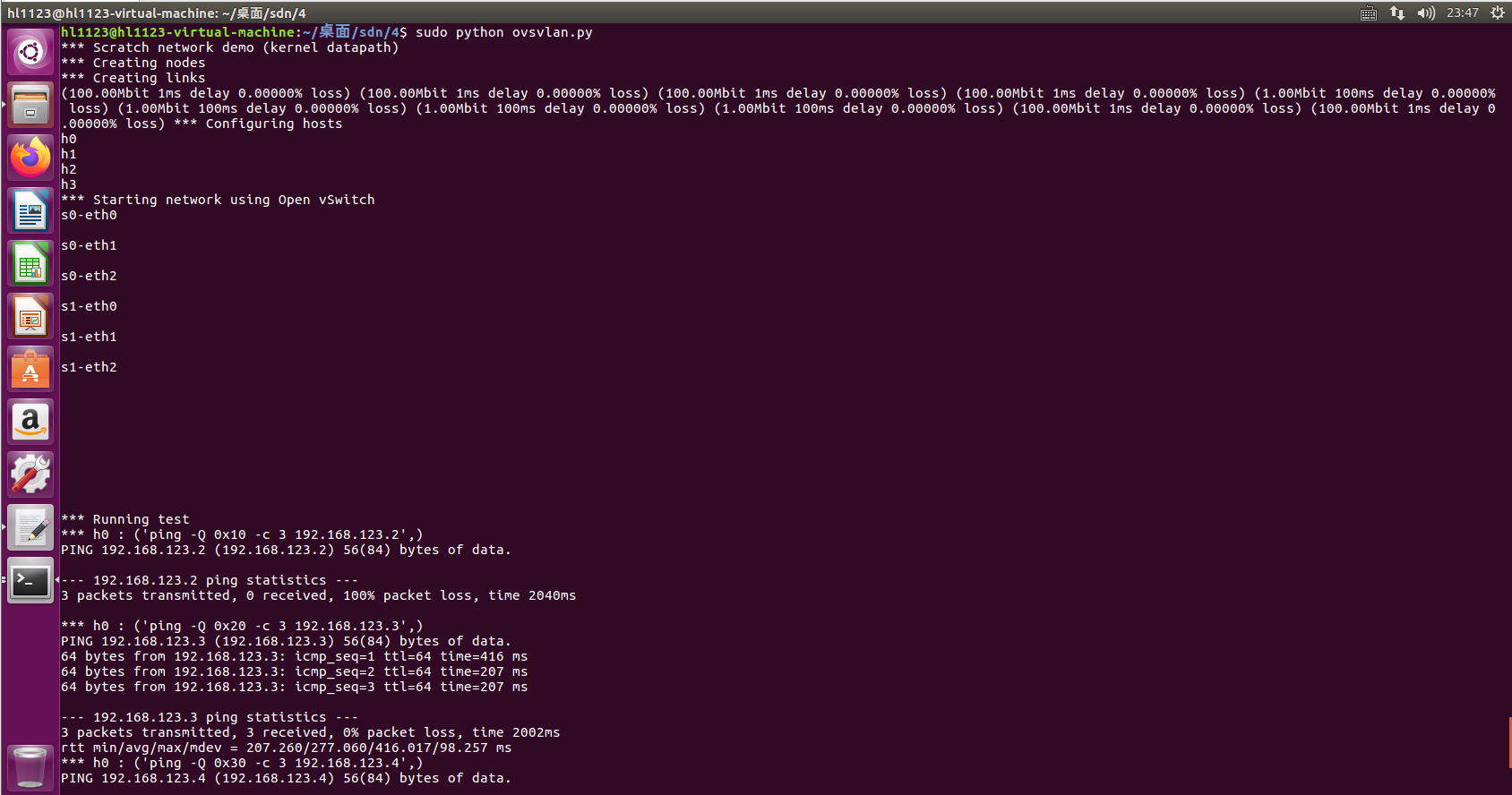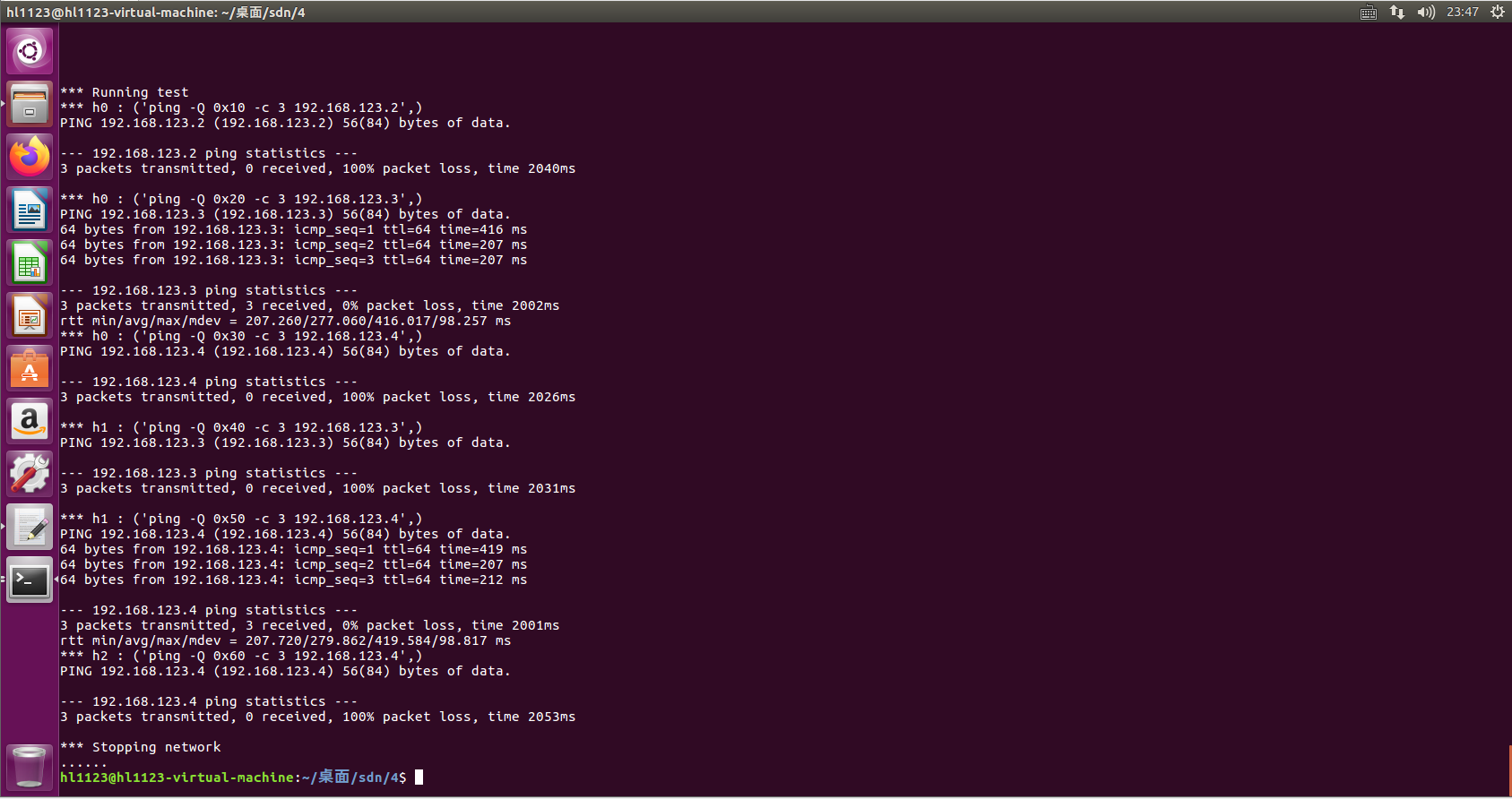实验 4:Open vSwitch 实验——Mininet 中使用 OVS 命令
一、实验目的
Mininet 安装之后,会连带安装 Open vSwitch,可以直接通过 Python 脚本调用
Open vSwitch 命令,从而直接控制 Open vSwitch,通过实验了解调用控制的方法。
二、实验任务
-
学习 ovsSingleBr.py 和 ovsMultiBr.py,在下图拓扑中实现一个 VLAN。

上述代码将 h0 和 h2 划分在 VLAN 0 中,h1 和 h3 划分在 VLAN 1 中,由于拓扑没
有控制器,并且初始化时删除了交换机中的所有流表,因此除非下发流表,否则
主机之间网络无法连通。请尝试修改代码,利用 ovs 命令直接下发 VLAN 设置的
流表项,最终测试 h0 和 h2 互通,h1 和 h3 互通,其余主机均不通,结果如下图。
OVS 实现 VLAN。
- 在博客园发表一篇博客,记录主要步骤。
三、实验步骤
1.实验环境
安装了 Ubuntu 18.04.5 Desktop amd64 的虚拟机
2.实验过程
(1)新建 ovsvlan.py ,使其实现实验任务中的功能。
gedit ovsvlan.py
(2)ovsvlan.py 脚本代码
#!/usr/bin/python
from mininet.net import Mininet
from mininet.node import Node
from mininet.link import TCLink
from mininet.log import setLogLevel, info
def myNet():
"Create network from scratch using Open vSwitch."
info( "*** Creating nodes
" )
switch0 = Node( 's0', inNamespace=False )
switch1 = Node( 's1', inNamespace=False )
h0 = Node( 'h0' )
h1 = Node( 'h1' )
h2 = Node( 'h2' )
h3 = Node( 'h3' )
info( "*** Creating links
" )
linkopts0=dict(bw=100, delay='1ms', loss=0)
linkopts1=dict(bw=1, delay='100ms', loss=0)
TCLink( h0, switch0, **linkopts0)
TCLink( h1, switch0, **linkopts0)
TCLink( h2, switch1, **linkopts1)
TCLink( h3, switch1, **linkopts1)
TCLink( switch0, switch1, **linkopts0)
info( "*** Configuring hosts
" )
h0.setIP( '192.168.123.1/24' )
h1.setIP( '192.168.123.2/24' )
h2.setIP( '192.168.123.3/24' )
h3.setIP( '192.168.123.4/24' )
info( str( h0 ) + '
' )
info( str( h1 ) + '
' )
info( str( h2 ) + '
' )
info( str( h3 ) + '
' )
info( "*** Starting network using Open vSwitch
" )
switch0.cmd( 'ovs-vsctl del-br dp0' )
switch0.cmd( 'ovs-vsctl add-br dp0' )
switch1.cmd( 'ovs-vsctl del-br dp1' )
switch1.cmd( 'ovs-vsctl add-br dp1' )
for intf in switch0.intfs.values():
print intf
print switch0.cmd( 'ovs-vsctl add-port dp0 %s' % intf )
for intf in switch1.intfs.values():
print intf
print switch1.cmd( 'ovs-vsctl add-port dp1 %s' % intf )
print switch0.cmd(r'ovs-ofctl -O OpenFlow13 add-flow dp0 priority=1,in_port=1,actions=push_vlan:0x8100,set_field:4096->vlan_vid,output:3' )
print switch0.cmd(r'ovs-ofctl -O OpenFlow13 add-flow dp0 priority=1,in_port=2,actions=push_vlan:0x8100,set_field:4097->vlan_vid,output:3' )
print switch0.cmd(r'ovs-ofctl -O OpenFlow13 add-flow dp0 priority=1,dl_vlan=0,actions=pop_vlan,output:1' )
print switch0.cmd(r'ovs-ofctl -O OpenFlow13 add-flow dp0 priority=1,dl_vlan=1,actions=pop_vlan,output:2' )
print switch1.cmd(r'ovs-ofctl -O OpenFlow13 add-flow dp1 priority=1,in_port=1,actions=push_vlan:0x8100,set_field:4096->vlan_vid,output:3' )
print switch1.cmd(r'ovs-ofctl -O OpenFlow13 add-flow dp1 priority=1,in_port=2,actions=push_vlan:0x8100,set_field:4097->vlan_vid,output:3' )
print switch1.cmd(r'sudo ovs-ofctl -O OpenFlow13 add-flow dp1 priority=1,dl_vlan=0,actions=pop_vlan,output:1' )
print switch1.cmd(r'sudo ovs-ofctl -O OpenFlow13 add-flow dp1 priority=1,dl_vlan=1,actions=pop_vlan,output:2' )
#switch0.cmd('tcpdump -i s0-eth0 -U -w aaa &')
#h0.cmd('tcpdump -i h0-eth0 -U -w aaa &')
info( "*** Running test
" )
h0.cmdPrint( 'ping -Q 0x10 -c 3 ' + h1.IP() )
h0.cmdPrint( 'ping -Q 0x20 -c 3 ' + h2.IP() )
h0.cmdPrint( 'ping -Q 0x30 -c 3 ' + h3.IP() )
h1.cmdPrint( 'ping -Q 0x40 -c 3 ' + h2.IP() )
h1.cmdPrint( 'ping -Q 0x50 -c 3 ' + h3.IP() )
h2.cmdPrint( 'ping -Q 0x60 -c 3 ' + h3.IP() )
#h1.cmdPrint('iperf -s -p 12345 -u &')
#h0.cmdPrint('iperf -c ' + h1.IP() +' -u -b 10m -p 12345 -t 10 -i 1')
#print switch0.cmd( 'ovs-ofctl show dp0' )
#print switch1.cmd( 'ovs-ofctl show dp1' )
#print switch2.cmd( 'ovs-ofctl show dp2' )
#print switch3.cmd( 'ovs-ofctl show dp3' )
#print switch4.cmd( 'ovs-ofctl show dp4' )
#print switch0.cmd( 'ovs-ofctl dump-tables dp0' )
#print switch0.cmd( 'ovs-ofctl dump-ports dp0' )
#print switch0.cmd( 'ovs-ofctl dump-flows dp0' )
#print switch0.cmd( 'ovs-ofctl dump-aggregate dp0' )
#print switch0.cmd( 'ovs-ofctl queue-stats dp0' )
#print "Testing video transmission between h1 and h2"
#h1.cmd('./myrtg_svc -u > myrd &')
#h0.cmd('./mystg_svc -trace st 192.168.123.2')
info( "*** Stopping network
" )
switch0.cmd( 'ovs-vsctl del-br dp0' )
switch0.deleteIntfs()
switch1.cmd( 'ovs-vsctl del-br dp1' )
switch1.deleteIntfs()
info( '
' )
if __name__ == '__main__':
setLogLevel( 'info' )
info( '*** Scratch network demo (kernel datapath)
' )
Mininet.init()
myNet()
上述代码将 h0 和 h2 划分在 VLAN 0 中,h1 和 h3 划分在 VLAN 1 中,由于拓扑没
有控制器,并且初始化时删除了交换机中的所有流表,因此除非下发流表,否则
主机之间网络无法连通。请尝试修改代码,利用 ovs 命令直接下发 VLAN 设置的
流表项,最终测试 h0 和 h2 互通,h1 和 h3 互通,其余主机均不通,结果如下图。
OVS 实现 VLAN 。
运行该 py 文件
$ python ovsvlan.py
运行结果截图:


三、实验总结
本实验中注意端口号的确定,是根据代码中的 TCLink 的顺序命名的。
在本实验中,了解了 OpenSwitch 中的 ovs-ofctl 命令以及 ovs-vsctl命令。